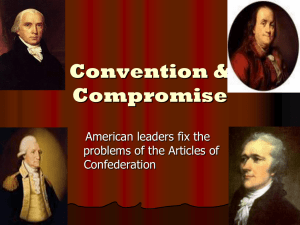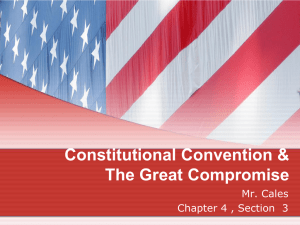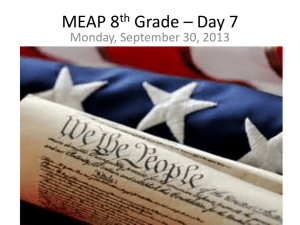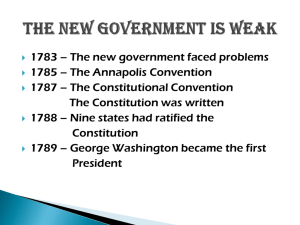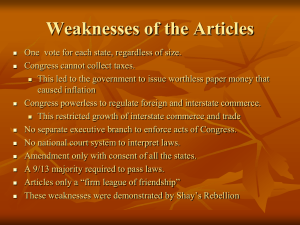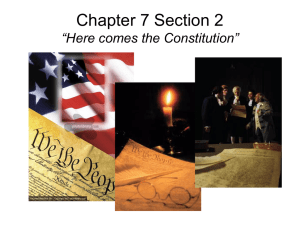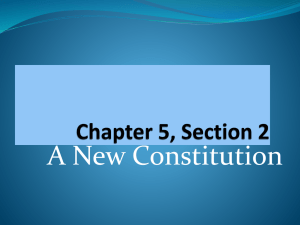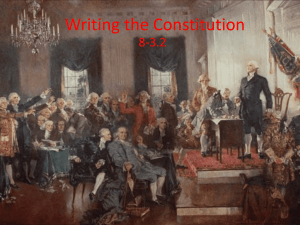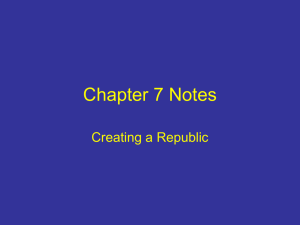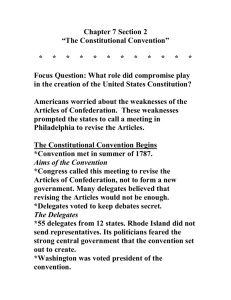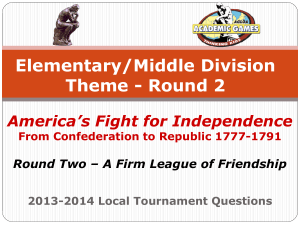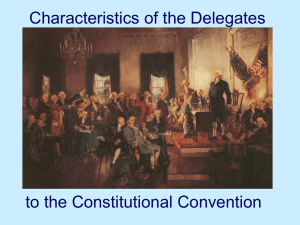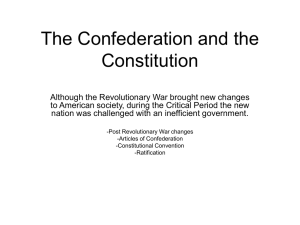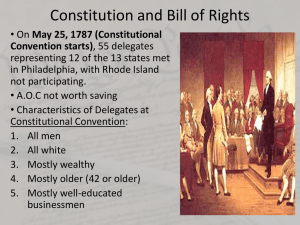Bellwork: February 24th
advertisement
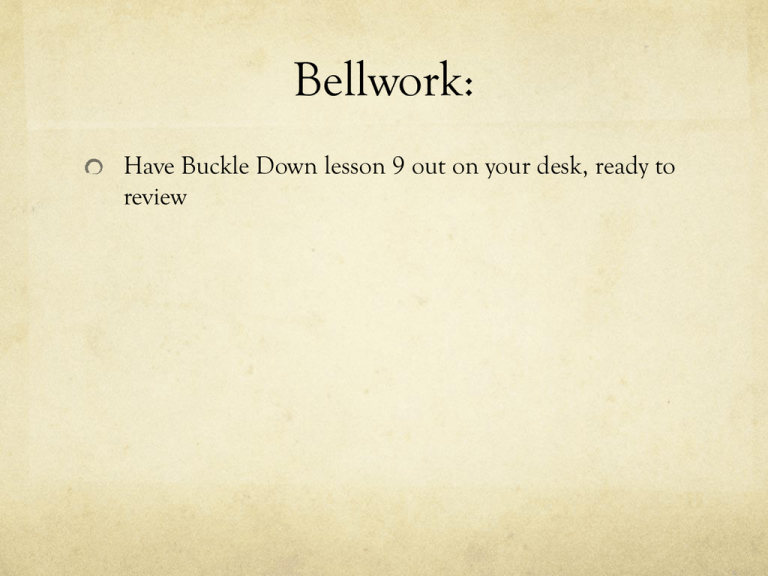
Bellwork: Have Buckle Down lesson 9 out on your desk, ready to review Class work OAT REVIEW Ch 8.3 Class Reading Read to remember Take notes: use note sheets Answer the following questions: Read to discover questions pg 236. Copy the question Define the following: Constitutional Convention, Virginia Plan, New Jersey Plan, 3/5 Compromise, Federalism Bellwork: Compromise: A settlement or agreement reached between two sides, where each side gives something to the other side. Journal: Describe a time when you had to compromise with someone. Who did you compromise with and what was the compromise? 8.3 and 8.4 Upcoming Change By the mid 1780’s most political leaders agreed the Articles of Confederation need to be changed Confederation Congress invited each state to send delegates to a convention in Philadelphia Would discuss ways to improve Articles of Confed. Meeting was called The Constitutional Convention 12 states sent 55 delegates to the convention Would lead to the creation of the U.S. Constitution Constitutional Convention Key figures present: James Madison Benjamin Franklin George Washington Key figures absent John Adams Thomas Jefferson How is our country being represented? The Great Compromise Some members wanted to make small changes to the Articles of Confederation Some wanted to rewrite the Articles completely There were also disagreements between: small and large states; based on how they would be represented in the new government about slavery Economic issues such as tariffs How strong to make the national government Virginia Plan Large-state plan Written by James Madison Would give sovereignty-supreme power, to the national government Divided the gov’t into three branches: Executive, Judicial, Legislative Legislature would be bicameral- two houses # of representatives of the legislature would depend on state population This would benefit large states, giving them more representatives New Jersey Plan Small-state plan Proposed keeping Congress’ structure the same Unicameral-one house legislature This would give each state an equal # of votes This would benefit smaller states, as large population had no effect on the # of votes. Great Compromise Cont’d Convention could not agree after months of debate A compromise was reached The Great CompromiseEvery state, regardless of its size would have an equal vote in the upper house of the legislature Senate Each state would have a # of representatives based on its population in the lower house of the legislature House of Representatives The Three-Fifths Compromise The debate over representation (how to count people) also led to problems Some Southern delegates wanted to count slaves as part of their state populations Northern delegates disagreed, thought it was unfair Delegates accepted the Three-Fifths compromise. Each slave would count as 3/5 of a person (100 slaves = 60) Main Concepts Most of the delegates wanted a strong national government Popular Sovereignty- idea that political authority belongs to the people Balance power of national government with power of the states Federalism- sharing of power between a central government and the states Federal gov’t has power to enforce laws States must obey authority of Federal gov’t Federal gov’t has the power to use the military to enforce laws Troops are under the command of the president States have control over areas not assigned to Federal gov’t Balance of Power Legislative Branch: Congress Proposes and passes laws 2 houses: Senate and House of Representatives Executive Branch: President Enforces laws, assures they are carried out Commander-in-Chief of the military Judicial Branch: Courts Interprets laws, punishes criminals Settles disputes between states Checks and Balances Kept one branch from gaining too much power Ex: Congress proposes and passes laws President can veto, or reject, that law Congress can override veto with a 2/3 majority vote Judicial Branch interprets laws to keep other branches from abusing power Supreme Court reviews laws passed by Congress Federalists vs. Antifederalists Antifederalists- those that opposed the constitution Felt the central gov’t had too much power Upset that no Bill of Rights was included Federalists- supported the constitution Felt it offered a good balance of power Federalist Papers- essays written supporting the Constitution Many written by James Madison and Alexander Hamilton Propaganda supporting the Constitution Ratification The Constitution needed approval of 9 states to become ratified Each state held conventions to give citizens the chance to discuss the Constitution They could then vote whether or not to ratify it June 1788, Constitution was ratified Bill of Rights Amendments- official changes, corrections, or additions The Bill of Rights would appear as a series of Amendments to the Constitution The first 10 amendments to the Constitution are known as the Bill of Rights Made sure the abuses listed in the Declaration of Independence would be illegal Would protect citizens’ individual rights Constitution’s flexibility Has clear guidelines and principles Can be changed and updated to stay current with new times and challenges Often called a “living constitution” Bellwork: Map Skills Have out Chapter 8 Note sheet to be checked Answer questions on page 243 According to the map, which states had the most complete federalist support? In what month and year did the first three states ratify the constitution? Which states are the most anti-federalist? Bellwork Answers ① Delaware and New Jersey ② December 1787 ③ New York, North Carolina, Rhode Island Group Work In your groups, complete the OAT Review Packet Read the Packet together! Answer the questions together as you read Double check that your answers are correct. Use the text! Only one answer sheet per group needs to be turned in.
